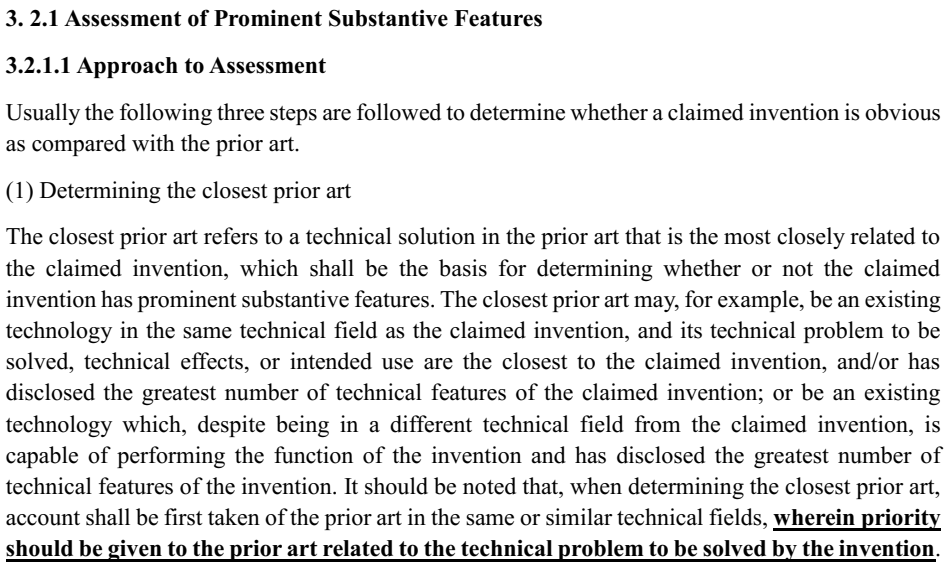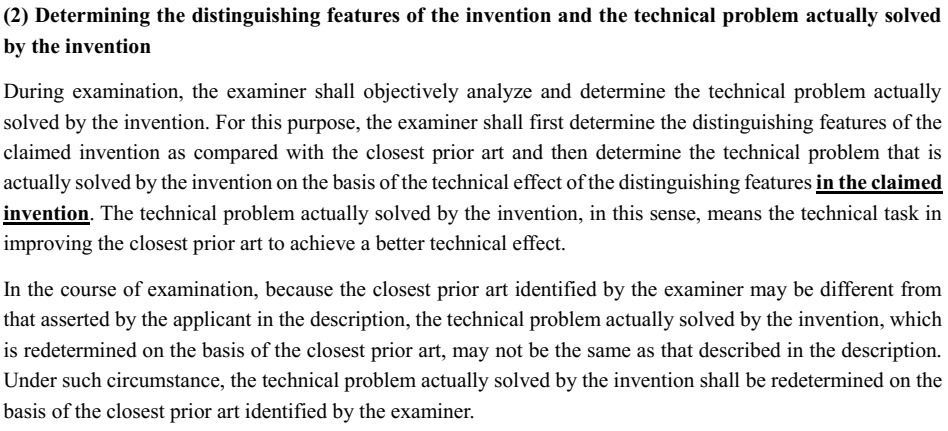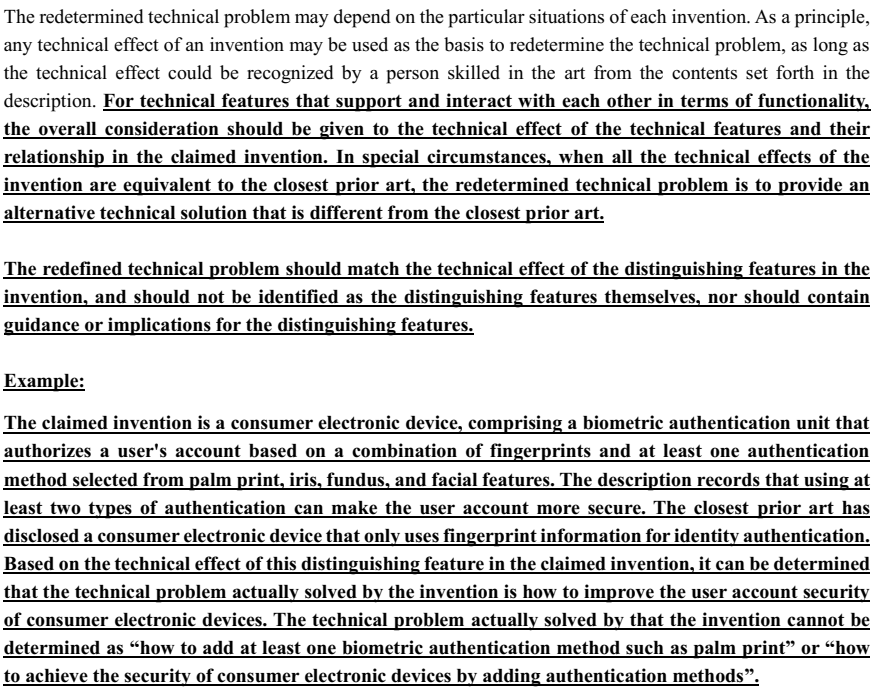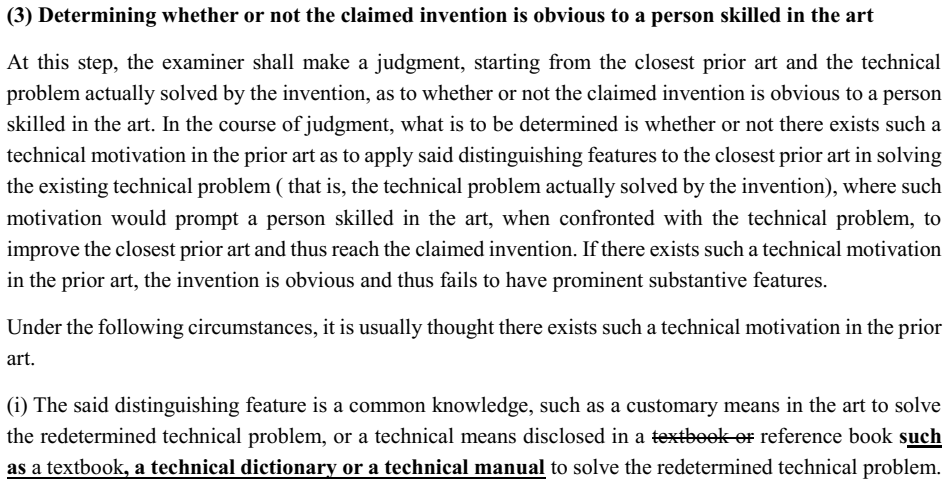Meng Jiexiong
The Guidelines for Patent Examination (hereinafter referred to as the Guidelines) give instructions on the practice and procedure to be followed in the various aspects of the examination of Chinese applications and patents in accordance with the Patent law and its Implementing Regulations. The 2024 edition enters into force on January 20, 2024, superseding the 2010 edition. The Guidelines systematically refine the examination standards for inventiveness, including appropriately handling the relationship between independent and dependent claims in inventiveness examination, how to determine the closest prior art, and accurately determining the technical problem actually solved by the invention.
The updates in the 2024 edition regarding inventiveness examination involve the following four aspects:
1. Clarification of the Relationship between Independent and Dependent Claims in Inventiveness Examination

The 2010 edition, in Chapter Four, Section 3.1, states that “If an independent claim involves an inventive step, there is no need to examine the inventive step of its dependent claims.”
In practice, in certain cases such as when a patent application claims a priority, if the priority of an independent claim is established, while the priority of a dependent claim is not, some intermediate documents may not affect the novelty and inventiveness of the independent claim but could impact the novelty and inventiveness of the dependent claim.
To enhance examination quality and improve the stability of the granted patent, the 2024 edition modifies “there is no need to examine the inventive step of its dependent claims” to “there is generally no need to examine the inventive step of its dependent claims”.
Therefore, in foreseeable examination practices, for patent applications that claim priority, the examiner will verify whether all claims enjoy priority. After determining the inventiveness of an independent claim, a reevaluation of the inventiveness of a dependent claim without priority will be conducted.
2. Prioritizing Factors when Determining the Closest Prior Art

The 2010 edition in Chapter Four, Section 3.2.1.1, outlines several factors to consider when determining the closest prior art, including the technical field, the technical problems to be solved, achieved technical effects, or purposes, and/or the technical features disclosed in the known prior art.
However, in practice, there have also been cases where the determination of the closest prior art only emphasizes the number of common technical features, and does not pay attention to whether the technical problem addressed by the prior art is relevant to the technical problem to be solved by the invention, thereby resulting in a deviation in inventiveness assessment.
The 2024 edition explicitly states that when determining the closest prior art, not only should the technical field be considered, but also the technical problem solved by the prior art should be taken into account. As much as possible, the prior art that is related to the technical problem to be solved by the invention in the same and/or similar technical field should be prioritized as the closest prior art for assessing the inventiveness of the invention.
In this regard, the Guidelines for examination in the EPO (Part G, Chapter VII, Section 5.1) states that the closest prior art is that which in one single reference discloses the combination of features which constitutes the most promising starting point for a development leading to the invention. In selecting the closest prior art, the first consideration is that it must be directed to a similar purpose or effect as the invention or at least belong to the same or a closely related technical field as the claimed invention.
Secondly, another criterion for selecting the most promising starting point is the similarity of technical problem. This kind of “technical problem” can be a problem already mentioned in the patent application. If a prior art does not involve the technical problem mentioned in the invention specification, it usually cannot be used as the closest prior art to evaluate the inventiveness of the invention, even if the prior art may share many technical features with the invention.
Therefore, in the selection of the closest prior art, the 2024 edition has reached a consensus with the Guidelines for examination in the EPO.
Example:
The invention relates to the field of respiratory gas monitoring and more specifically to a replaceable filter for a gas sampling system. The technical problem addressed by the invention is providing additional space for an external filter of a multi-parameter medical monitoring device, as placing the filter inside the device prevents users from replacing the filter without exiting the service.
D1, as the closest prior art, cited by the examiner, relates to a gas pollutant continuous monitoring universal direct extraction probe. It is used in the direct extraction gas subsystem of a continuous emission monitoring system for fixed pollution sources, aiming to overcome problems such as filter blockage, difficult cleaning, short usage cycles, high air path resistance, and inconvenient disassembly and installation.
According to the 2024 edition, D1 does not serve as the closest prior art since there is a significant gap between D1’s technical field (“gas pollutant continuous monitoring”) and the invention's technical field (“respiratory gas monitoring”), and D1 does not address similar technical problem. Therefore, D1 would not be selected as the closest prior art for assessing the inventiveness.
3. Improvement in Determining the Technical Problem Actually Solved by the Invention


The 2010 edition states that the technical problem actually solved by the invention means “the technical task in improving the closest prior art to achieve a better technical effect.” However, in practice, some inventions, compared to the closest prior art, may have comparable technical effect and may have not shown “better technical effect.” Still, they provide an alternative technical solution with a different technical concept. The 2010 edition does not cover this situation, leading to some degree of disagreement in understanding.
To address this, the 2024 edition introduces three modifications:
a. When redefining the technical problem actually solved by the invention, a special circumstance is added. Specifically, “when all the technical effects of the invention are equivalent to the closest prior art, the redetermined technical problem is to provide an alternative technical solution that is different from the closest prior art” to comprehensively reflect the laws and characteristics of innovation.
b. It emphasizes the need for an objective analysis to determine the technical problem actually solved by the invention. Objectivity, in this context, means, on one hand, basing the redefined technical problem on the technical effects achievable by the distinguishing features in the invention, ensuring it is neither too broad nor too specific. On the other hand, the technical problem actually solved should not include the technical means proposed by the invention to solve the problem. It should neither be determined as the distinguishing features themselves nor contain guidance or implications for the distinguishing features to avoid falling into the ex post facto analysis in subsequent assessment of technical motivation.
c. A new case involving a consumer electronic device is added to further illustrate how to redefine the technical problem actually solved by the invention.
Example:
The invention relates to a radiation detector. The examiner admits that D1 does not disclose “each pixel comprises an array of sub-pixels”, “each sub-pixel or a group of adjacent sub-pixels is surrounded by the trench”, and “the filling factor of the barrier material in the trench varies progeammably across the detector, wherein a first portion of the trench has a filling factor of the barrier material that is different from the filling factor of a second portion of the trench, the first portion of the trench surrounds a pixel and the second portion of the trench surrounds a sub-pixel or a cluster of sub-pixels” in independent claim 1
The examiner first determines whether the concept of the term “sub-pixels”, as a distinguishing feature, belongs to common general knowledge and, under this judgment, determines that the technical problem actually solved by the invention is to “optimize the crosstalk effect around pixels and sub pixels separately.”
In fact, the description recites explicitly that the radiation detector of claim 1 “allows for an increased coverage of the active area of the array of sub-pixels at the cost of accepting some crosstalk between sub-pixels of the array” and “advantageously provides for optimization between the material used for filling, the size of the trench and the resulting quality of the filling process.”
Therefore, according to the provisions of the 2024 edition on how to determine the technical problem actually solved by the invention, based on the technical effects achieved by the distinguishing technical features in the invention, the technical problem actually solved by the invention can be “providing an improved radiation detector that balances radiation crosstalk with the coverage area of active pixels, and optimizes manufacturing processes.”
4. Supplementing Types of Evidence for Common General Knowledge

The 2010 edition in Parts II and IV enumerate the types of evidence for common general knowledge.
The 2024 edition, following the provisions in Part IV, Chapter 8, Section 4.3.3, adds “technical dictionary, technical manual” as examples of reference tools. This indicates that when presenting evidence of common general knowledge, relevant information can be sought in the technical dictionary and/or technical manual.
In conclusion, the revisions in the 2024 edition contribute to a more thorough and objective examination of inventiveness, aligning with international best practices and promoting a fair and effective patent examination process.
Meng Jiexiong
Mr. MENG's practice focuses on patent drafting, filing and prosecution, patent invalidation and infringement litigation, patent assessment, and patent-related legal advice in the fields of medical device, image processing, electric engineering, computer science, mobile communication, etc. He has extensive experience in drafting patent applications, replying to office actions and appealing reexaminations. He has handled a great number of patent applications from famous medical companies in the world. He is good at technical understanding and analysis, and could always provide valuable suggestions for his clients. He is experienced in patent invalidation. The clients he served include Philips, ResMed, Panasonic, Qualcomm, Intel, etc.